Winners: Wildlife Photographer of the Year 2017
The Wildlife Photographer of the Year announced the winners of the 2017 contest at a gala ceremony in London’s Natural History Museum last Tuesday. Showcased here are the winning images that have marine themes.
A notable omission is Thomas Peschak’s winning portfolio of (largely) underwater images entitled “Realm of the Seychelles.”
The 2018 (#WPY54) contest opens for entries on Monday 23 October.
Giant Gathering
Tony Wu, USA
Winner 2017, Behaviour: Mammals
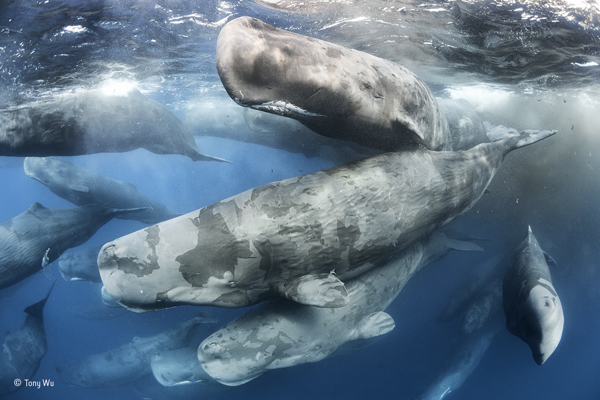
Dozens of sperm whales mingled noisily off Sri Lanka’s northeast coast, stacked as far down as Tony could see. This was part of something special–a congregation of dozens, perhaps hundreds, of social units, like a kind of gathering of the clans. Sperm whales are intelligent, long-lived and gregarious, and groups play, forage, interact and communicate in different ways and have distinctive cultures. Aggregations like this could be a critical part of their rich, social lives but are rarely reported. Some two-thirds of the sperm whale population was wiped out during the peak of industrialized whaling in the twentieth century.But commercial whaling was banned in 1986, and this kind of major gathering could be ‘a sign that populations are recovering’, says Tony, who has spent 17 years studying and photographing sperm whales. Tactile contact is an important part of sperm whale social life, but rubbing against each other also helps slough off dead skin. So the water was filled with a blizzard of skin flakes. More photographically challenging was the smearing of the camera‑housing dome with oily secretions from the whales and thick clouds of dung released as they emerged from the gigantic cluster. But through continually swimming to reposition himself and the tolerance of the whales themselves, Tony got a unique photograph of the mysterious Indian Ocean gathering.
Canon EOS 5D Mark III + 15mm f2.8 lens; 1/250 sec at f6.3; ISO 800; Zillion housing + Pro-One optical dome port.
The Jellyfish Jockey
Anthony Berberian, France
Winner 2017, Underwater
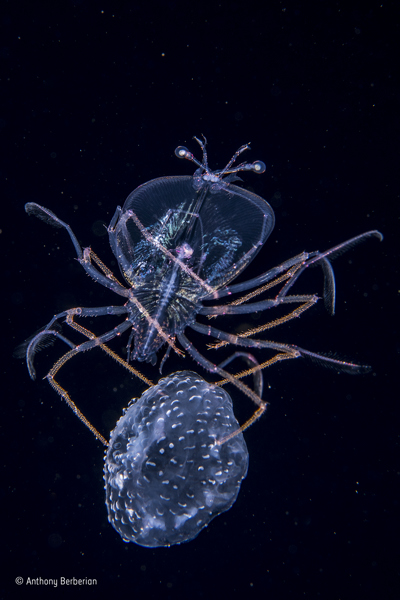
In open ocean far off Tahiti, French Polynesia, Anthony regularly dives at night in water more than 2 kilometres (1¼ miles) deep. His aim is to photograph deep-sea creatures-tiny ones, that migrate to the surface under cover of darkness to feed on plankton. This lobster larva (on top), just 1.2centimetres (half an inch) across, with spiny legs, a flattened, transparent body and eyes on stalks, was at a stage when its form is called a phyllosoma. Its spindly legs were gripping the dome of a small mauve stinger jellyfish. The pair were drifting in the current, the phyllosoma saving energy and possibly gaining protection from predators deterred by the jelly’s stings, its own hard shell probably protecting it from stings. The phyllosoma also seemed able to steer the jelly, turning it around at speed as it moved away from Anthony. The odd thing about the jelly was that it had few tentacles left, suggesting that the little hitchhiker was using it as a convenient source of snacks. In fact, a phyllosoma has a special digestion to deal with jellyfish stinging cells, coating them with a membrane that stops the stings penetrating its gut. In several hundred night dives, Anthony met only a few lobster larvae, and it took many shots of the jellyfish jockey to get a composition he was happy with a portrait of a creature rarely observed alive in its natural surroundings.
Nikon D810 + 60mm f2.8 lens; 1/250 sec at f22 (−0.3 e/v); ISO 64; Nauticam housing + Nauticam SMC-1 super-macro converter; InonZ-240 strobes.
Crab Surprise
Justin Gilligan, Australia
Winner 2017, Behaviour:Invertebrates
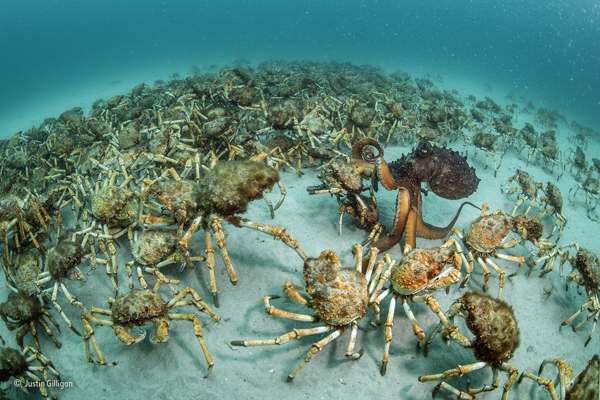
Out of the blue, an aggregation of giant spider crabs the size of a football field wandered past. Known to converge in their thousands elsewhere in Australian waters-probably seeking safety in numbers before moulting–such gatherings were unknown in Mercury Passage off the east coast of Tasmania. Justin was busy documenting a University of Tasmania kelp transplant experiment and was taken completely by surprise. A single giant spider crab can be hard to spot–algae and sponges often attach to its shell, providing excellent camouflage–but there was no missing this mass march-past, scavenging whatever food lay in their path on the sandy sea floor. “About 15 minutes later, I noticed an odd shape in the distance, moving among the writhing crabs,” says Justin. It was a Maori octopus that seemed equally delighted with the unexpected bounty. Though large–the biggest octopus in the southern hemisphere, with muscular arms spanning up to 3metres (10 feet) and knobbly, white-spotted skin–it was having trouble choosing and catching a crab. Luckily for Justin, the stage was set with clear water and sunlight reflecting off the sand. He quickly adjusted his camera and framed the octopus finally making its catch.
Nikon D810 + 15mm f2.8 lens; 1/100 sec at f14; ISO 400; Nauticam housing; two Ikelite DS161 strobes.
The Ancient Ritual
Brian Skerry, USA
Winner 2017, Behaviour:Amphibians and Reptiles
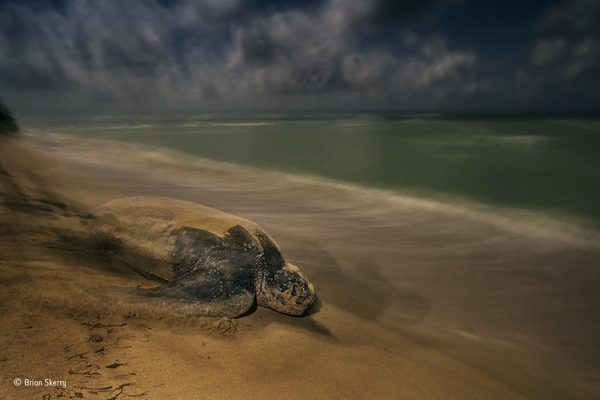
Like generations before her, the leatherback turtle shifts her considerable weight with her outsized, strong front flippers and moves steadily back to the ocean. Leatherbacks are the largest, deepest-diving and widest-ranging sea turtles, the only survivors of an evolutionary lineage that diverged from other sea turtles 100–150 million years ago. Much of their lives are spent at sea, shrouded in mystery. When mature, their leathery shells now averaging 1.6 metres (5 feet 3 inches) long, females return to the shores where they themselves hatched to lay their own eggs. Sandy Point National Wildlife Refuge on St Croix, in the US Virgin Islands, provides critical nesting habitat, successfully managed for decades. Elsewhere, leatherbacks are not so lucky, threatened primarily by fisheries bycatch as well as factors including human consumption, coastal development and climate change. The females each lay about 100 eggs in nests dug deep in the sand. Some 60 days later, the hatchlings emerge, their sex influenced by incubation temperatures (hotter nests produce more females). Nesting turtles are not seen every night at Sandy Point, and were often too far away for Brian to reach. When after two weeks he got the encounter he wanted–under clear skies, with no distant city lights-he hand-held a long exposure under the full moon, artfully evoking a primordial atmosphere in this timeless scene.
Nikon D5 + 17–35mm f2.8 lens at 24mm; 10 sec at f8; ISO 1600; Nikon flash at 1/64th power + tungsten gel; Nikon remote release.
The Ice Monster
Laurent Ballesta, France
Winner 2017, Earth’s Environments
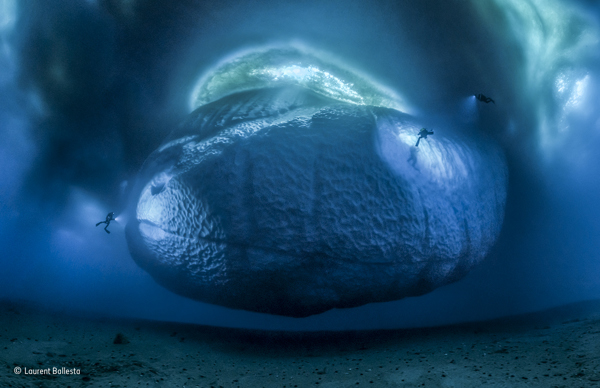
Laurent and his expedition team had been silenced by the magnitude of the ice blocks-mountainous pieces of the ice shelf–awed in the knowledge that only 10 per cent of their volume is ever visible above the surface. The dive team were working out of the French Dumont d’Urville scientific base in east Antarctica, recording with film and photography the impact of global warming. Ice shelves in some parts of the East Antarctic Ice Sheet are melting faster than scientists had previously assumed, threatening a movement of land ice into the sea and raising sea levels dramatically. When Laurent spotted this relatively small iceberg, he saw the chance to realize a long-held ambition-to show for the first time the underwater part. The berg was stuck in the ice field-hovering like a frozen planet–unable to flip over and so safe to explore. But it took three days, in virtually freezing water, to check out the location, install a grid of lines from the seabed to buoys (so that Laurent could maintain a definite distance from it) and then take the series of pictures–a substantial number, with a very wide‑angle lens-to capture the entire scene. ‘None of us could see the whole thing under water. Close-to, it was overflowing from our view. From a distance, it disappeared into the fog.’ So, back at the station, it was a tense wait at the computer, while the result of 147 stitched images came together on screen. The front of the vast foot of the frozen monster, polished by the current probably over years, shone turquoise and blue in the light penetrating the ice ceiling, dwarfing Laurent’s companions as they lit its sides.
Nikon D4S + 13mm f2.8 lens; 1/30 to 1/60 sec at f6.3 –147 stitched images; ISO 3200; Seacam housing; flashlights.